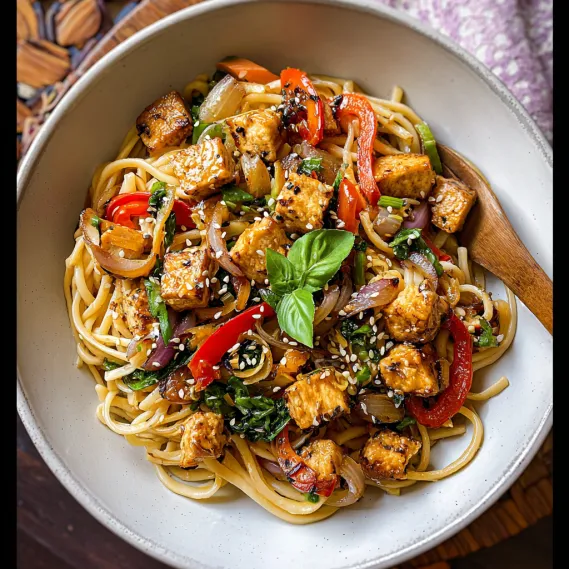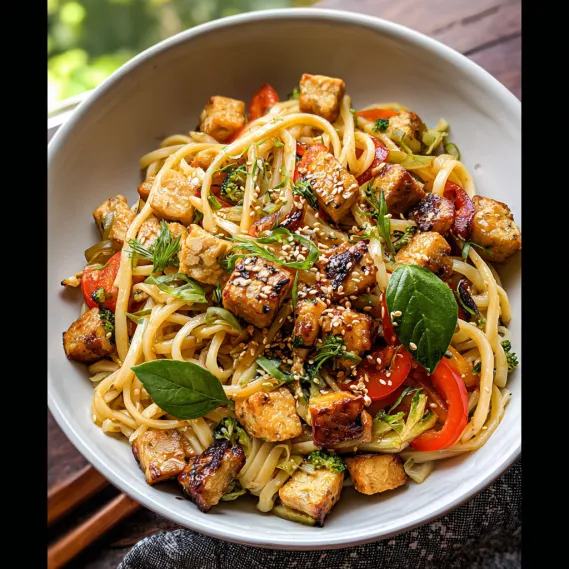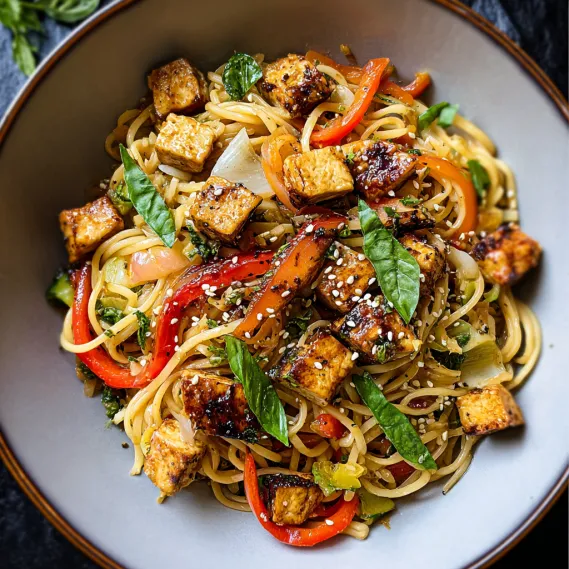 Pin
Pin
This Tofu Noodle Stir-Fry is my weeknight hero for days when I want something nourishing with just one big skillet to wash at the end. Loaded with crispy golden tofu and a rainbow of veggies, tossed through springy noodles in a sticky Asian-inspired sauce, it never fails to cheer everyone up at the table.
I first tried this on a night when my fridge looked nearly empty but somehow with just tofu and a couple of peppers I made something every bit as good as takeout and my family asked for it again the next day.
Ingredients
- Linguine noodles: for a hearty base any long noodle works but aim for one with a bit of bite
- Extra firm tofu: choose a dense one because it will fry up crisp and hold together in the sauce
- Corn starch: helps create a shatteringly crisp coating on the tofu little trick I never skip
- Oil: neutral high heat oil like avocado or canola is best for an even sear
- Low sodium soy sauce: the foundation for your stir fry sauce for flavor without over salting
- Hoisin sauce: brings a gentle underlying sweetness and complexity opt for a thicker brand if you can
- Sesame oil: for that deep nutty aroma a little goes a long way so buy toasted if you can
- Maple syrup: a touch of this softens the spicy salty flavors and brings balance
- Gochujang: rich Korean chili paste adds a subtle heat and extra dimension look for a smooth paste in a bright red tub
- Rice vinegar: for brightness and a little tang helps all the flavors pop
- Sesame seeds: add some crunch as a final touch use fresh for the best flavor
- Garlic and fresh ginger: both minced build a bold aromatic base dont skip or skimp here
- Bell peppers: ideally two colors for both sweetness and color choose ones that are glossy and firm
- Yellow onion: slivers their slight sweetness rounds out the sharpness of the sauce
- Jalapeno: gives a hit of heat but is fully optional remove seeds for less spice
- Carrot: shredded for a tender colorful finish the thinner the better
- Green onion sesame seeds fresh basil: reserved for serving and extra flavor always use just cut herbs for garnish
Step-by-Step Instructions
- Boil the Noodles:
- Bring a large pot of water to a boil and cook the noodles until just shy of done about one minute less than the package suggests. Rinse with cold water to stop cooking and prevent sticking.
- Crisp the Tofu:
- Cut the pressed tofu into bite sized cubes and toss with corn starch. Heat half the oil in a large skillet over medium heat. Place the tofu pieces in and cook until each side turns golden and crisp. This step takes patience but it is worth it for the best texture.
- Prepare the Sauce:
- As the tofu cooks, whisk together the soy sauce, hoisin, sesame oil, maple syrup, gochujang, rice vinegar, sesame seeds, garlic, and ginger in a bowl until smooth. Make sure all the ginger and garlic are thoroughly mixed in for maximum aroma.
- Caramelize the Tofu:
- Once tofu is golden, pour in half the sauce. Gently mix so every cube is glazed and sticky. Allow the tofu to absorb the sauce and develop caramelized edges, then scoop it out and keep aside.
- Sauté the Veggies:
- Return the empty skillet to the stove and add the remaining oil. Add sliced onion, bell peppers, carrot, and jalapeno if using. Cook over medium heat, stirring often, until veggies are tender and a little charred on the edges to boost flavor.
- Bring it Together:
- Add noodles and the rest of the sauce to the pan. Toss everything together and let the noodles soak up the sauce as they finish cooking. Finally, fold the tofu back in, stirring until it is evenly distributed and everything is piping hot.
- Finish and Serve:
- Spoon into bowls and top each portion with green onion, sesame seeds, and basil. Serve hot, preferably straight from the skillet for maximum freshness.
 Pin
Pin
I am obsessed with gochujang for its subtle backbone of heat and umami it is what really sets this dish apart from basic takeout noodles and gives everyone that wow moment at first bite. My favorite memory is cooking this with my niece as we both snuck extra pieces of caramelized tofu right from the pan.
Storage Tips
Leftovers keep covered in the fridge three days. When reheating, add a splash of water to loosen the noodles and revive the sauce. For a speedy packed lunch, portion into microwave-safe containers and store with the topping garnishes on the side.
Ingredient Substitutions
Swap linguine for rice noodles or soba for a gluten free option. Tamari stands in for soy sauce if gluten is a concern. If you cannot find hoisin, a spoonful of peanut butter mixed with a little extra maple syrup works in a pinch.
Serving Suggestions
I like to round out the meal with steamed edamame or a crisp cucumber salad on the side. For a family style feast, serve the stir fry alongside bowls of hot jasmine rice and a platter of pickled veggies to contrast the rich sauce.
 Pin
Pin
Cultural Context
This dish borrows from the essentials of East Asian street food stir fries where high heat quick cooking locks in crunch and color. The addition of gochujang nods to Korean flavor traditions, while using pantry linguine gives it a comforting flexibility found in home kitchens everywhere.
Recipe FAQs
- → How do I achieve crispy tofu?
Drain and press extra firm tofu well, then toss with corn starch before pan-frying in hot oil until golden on all sides.
- → Can I substitute rice noodles for linguine?
Yes, rice noodles work well—just cook according to the package instructions and proceed as directed.
- → What veggies pair best in this dish?
Bell peppers, shredded carrot, onion, and optional jalapeño provide crunch and color, but feel free to use any favorites.
- → How do I make the sauce more spicy?
Add extra gochujang or a pinch of red pepper flakes to increase the heat in your sauce.
- → How should leftovers be stored?
Store leftovers in an airtight container in the refrigerator for up to three days and reheat before serving.
